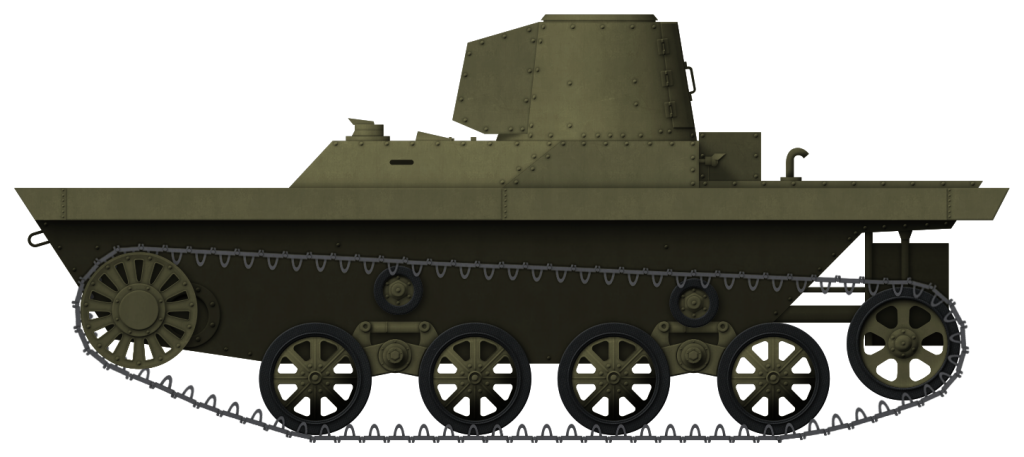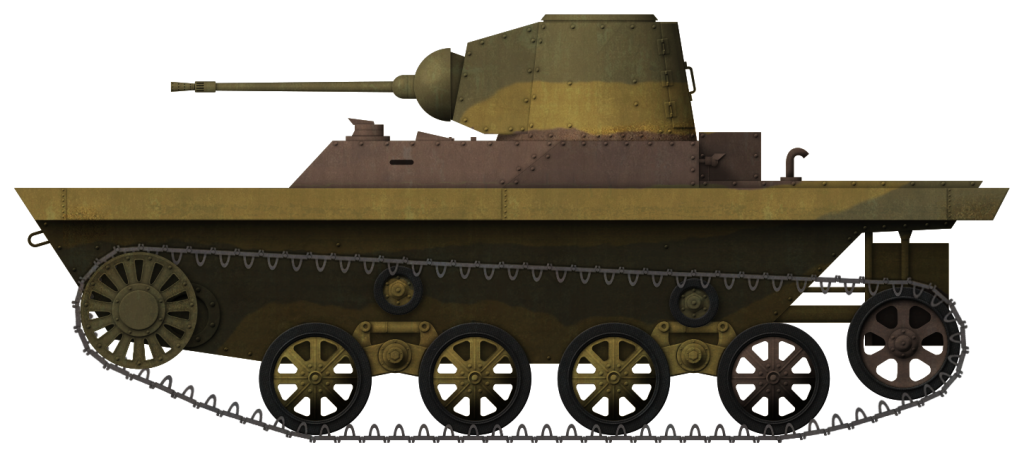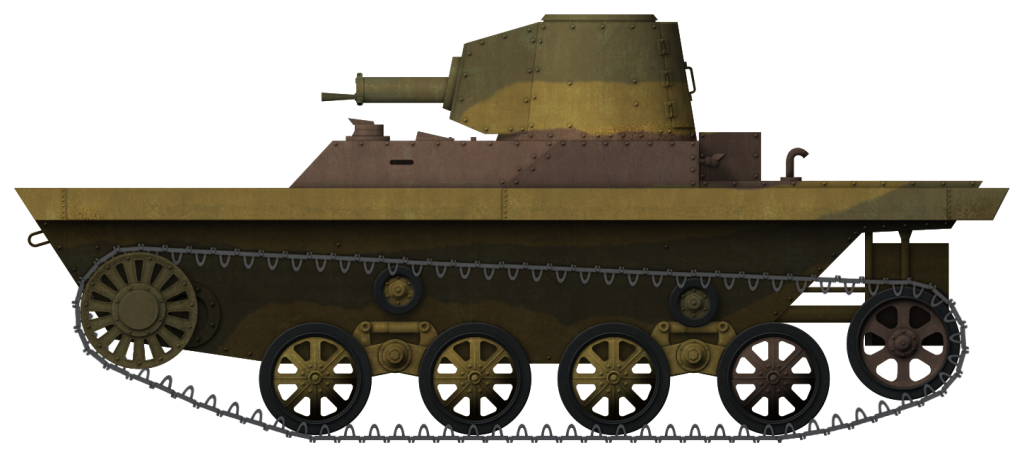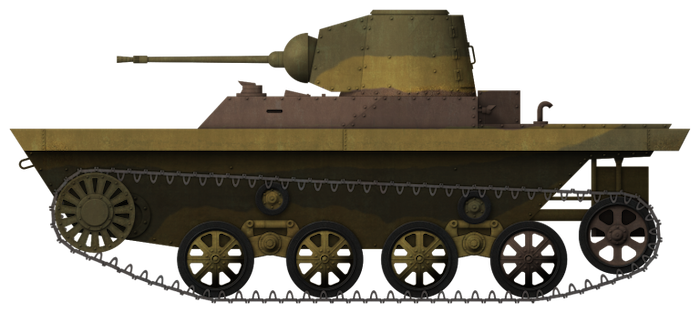 Republic of Poland (1937-1939)
Republic of Poland (1937-1939)
Light Amphibious Tank – 1 Prototype Built
At the end of the 1920s, the well-known tank designers from the Vickers company – engineers John Valentine Carden and Captain Vivian Loyd – built a new, specialized variant of a small reconnaissance tank, an amphibious vehicle known as the Vickers-Carden-Loyd Amphibian Tank.
The vehicle did not, however, pique the interest of the British War Office enough to place orders. By the end of 1931, Vickers received permission to export the tank and buyers were found almost immediately. The U.S.S.R. bought 8 tanks (on the basis of which they designed the T-37A and the T-38), Thailand (then known as Siam) bought 2, China bought 29, and the Netherlands ordered 2 for service in the Dutch East Indies. Interest in the tank was also shown by other countries, such as Japan, Finland, and Poland.

At the same time, Vickers also offered small two-man reconnaissance tanks and tractors for sale, all based around the same chassis. News of the new British designs soon reached the Polish Armored Command. Despite serial production of the TK tankettes and a finalized design for the TKS, the weapons development plan had foreseen the design of a small new light tank with its armament in a rotating turret and a more powerful machine gun, such as one with a caliber of 13 mm or even a 20 mm cannon. The tank was to potentially replace the TK/TKS tankettes in the near future.
For this reason, talks with a Vickers representative on the demonstration of the vehicles were started as early as 1932 in Warsaw. In September 1932, the British company shipped three vehicles to Poland – the amphibious tank, the 4 tonne reconnaissance tank and an artillery tractor, all based on the same chassis. They were demonstrated to representatives from various competent institutions and military authorities. The presentation of the amphibious tank’s capabilities took place in Modlin on 8th October 1932, on the banks of the Vistula near the Military Yacht Club. On 25th October of the same year, all three vehicles were demonstrated in Rembertów, near Warsaw, in which the amphibious tank’s ability to overcome ground obstacles and water hazards was greatly admired by the Polish committee.
As a result of these demonstrations, the head of the Department of Engineering Supply (Departament Zaopatrzenia Inżynierii), Colonel Tadeusz Kossakowski, presented a proposal to the Polish General Staff for the purchase of five 4-tonne tanks and one amphibious tank. These were to be a test bed for further research and models on which to base domestic designs.
The General Staff, however, only agreed to the purchase of three vehicles, but even these were never bought due to a lack of funds. Due to this, it was decided that similar vehicles were to be designed without acquiring foreign templates. The Armored Weapons Development Office (Biuro Badań Technicznych Broni Pancernych – BBT Br. Panc.) laid down the tactical and technical requirements for an amphibious tank and a 4-tonne tank design which was entrusted to PZInż (Państwowe Zakłady Inżynierii, the Polish National Engineering Works). Both vehicles were to be standardised and the components were to be highly interchangeable.
Light Amphibious Tank – PZInż. 130
Armored Command expected the amphibious tank to be used in operations in Eastern Poland, especially in the Polesie region, abundant with swamps, rivers and lakes, where normal tanks would have had difficulties due to the character of the terrain.
Design
The main designer of the PZInż. 130 (as well as the 4-tonne reconnaissance tank – the PZInż. 140) was the head of the Tanks Department of PZInż, Engineer Edward Habich.
Most of the components of the tank were unified with those of the PZInż. 140, including the engine, drive train, suspension and track mechanism (with the road wheels and tracks being of a lighter construction to reduce the overall weight). The turret was taken from the second variant of the TKW tankette and was to house a machine gun, with the possibility of also mounting a 20 mm auto-cannon in the future. The small weight to hull volume ratio, along with the hermetically sealed and the watertight construction allowed for the floatation of the tank. To ensure greater stability while floating, the track covers were built as floatation devices filled with cork. The vehicle was propelled in the water by a screw housed in a special retractable hydrodynamic cover, connected to the control levers and side clutches, and acting as a rudder. The power was transmitted from the engine through the transfer case independently of the momentum transmitted to the tracks, which allowed for the simultaneous movement of both the tracks and the propeller. This made it easier for the tank to drive into and out of the water as well as overcome obstacles in shallower waters.

Initial Trials
The design and technical documentation for the tank were completed in Autumn 1936. Work on the construction of the prototype started at the beginning of 1937 and finished in the summer of the same year. After a short series of factory tests, the tank was transferred to the military representatives on 15th August 1937 and demonstrated to officers from various institutions on 2nd October. During the demonstration in Beniaminów, the tank was driven by its designer despite the fact that this had been forbidden by the organisers fearing some unforeseen accident. Fortunately, neither the vehicle nor its designer were hurt during the trial.
From 5th October, the PZInż. 130, along with other prototype vehicles, took part in a test rally under the codename “Autumn 1937” (“Jesień 1937”). The route started in Warsaw and led through Brześć (present-day Brest), Wołkowysk (Vawkavysk), Pinsk, Łuck (Lutsk), Buczacz (Buchach), Stryj (Stryi), Żurawica, Lublin and ended up back in Warsaw with a total distance of about 1,861 km with around half of the route being driven off-road. Additional tests for the PZInż. 130 were carried out on Lake Lubiąż (Lyubyazh) and on the Pina River near Pinsk.

Further Trials and Eventual Fate
The overall evaluation of the tank by the military committee was positive – the power to weight ratio was favorable, the acceleration was good, and the tank could easily drive over rough and marshy terrain. The defects that were found were deemed normal for a newly-designed vehicle and, after the rally, the tank was returned to PZInż to introduce improvements and iron out mistakes.
The next test rally took place in May 1938 and led through the Knyszyn Forest to Vilnius Nieśwież (Nyasvizh) and Biała Podlaska with a combined distance of over 800 km which the PZInż. 130 also managed to complete with positive results. This proved the same in all subsequent tests, all of which the tank managed to complete without any significant failures. The last trial of the tank took place in May 1939 and the prototype drove a combined distance of over 3,500 km (other estimates place it as high as 5,000 km).
Unfortunately, at the same time, the General Staff decided there was no need for such a vehicle, and the prototype was returned to the Ursus test workshop. The reasons given were the lack of production capabilities for such a specialised vehicle, its comparatively thin armor and use of factory time which could be spent on building heavier and better armored tanks. At the outbreak of the Second World War, the vehicle most likely remained in the PZInż factory in Warsaw and in Spring 1940 was transported by rail to Germany, where it was put on display as a war trophy at the Leipzig Trade Fair.

Conclusion
The tank was marked by a great reliability of movement and an ability to cover large distances at a high average speed. The mechanisms were straightforward and the handling and maintenance procedures were very simple. The vehicle was well stabilized, as a result of which driving the tank did not tire out the crew. However, despite its obvious advantages the tank did not enter mass production due to the fact that it would have delayed the construction of much more urgently needed tanks, such as the 7TP, as well as the design of vehicles with substantially more firepower.


Illustration of the single prototype built in 1937.

Illustration of a Hypothetical in-service variant with the 20 mm wz. 38 FK-A autocannon.

Illustration of a Hypothetical in-service variant with the ckm wz. 30 machine gun
These illustrations were produced by the Author, Bernard Baker, and funded by our Patreon camapaign.
Specifications |
|
| Dimensions | 4.22 x 2.08 x 1.88 m (13.85 x 6.82 x 6.17 ft) |
| Total weight, battle ready | 3.92 tons (7,840 lb) |
| Crew | 2 (commander/gunner, driver) |
| Propulsion | PZInż. 425, 6-cyl, 95 hp, 24.2 hp/ton |
| Suspension | Torsion bar, leaf sprung bogies |
| Speed (road) | 60 km/h (37 mph) – on land 7-8 km/h (4-5 mph) – in water |
| Range | 360-220 km (225-135 mi)/58-66 l/100 km |
| Armament | 20 mm autocannon (proposed Nkm wz.38 FK) (200 rounds) or 7.92 mm machine gun (proposed Ckm wz. 30) (2500 rounds) |
| Armor | 4 to 8 mm (0.16-0.31 in) |
Sources
Czołg pływający PZInż. 130, Piotr Zarzycki (Wielki Leksykon Uzbrojenia Wrzesień 1939, Tom 141 Prototypy broni pancernej, 2018
Czołgi rozpoznawcze PZInż.-130 i PZInż.-140, Janusz Magnuski (Nowa Technika Wojskowa nr. 11/93, 1993)
Nowe rozdanie, czyli TKS wersji 2.0, Jędrzej Korbal (Technika Wojskowa Historia nr. spec. 6/17, 2017)
derela.pl/tkdpl.htm
Pojazdy Wojska Polskiego 1939, A. Jońca, R. Szubański i J. Tarczyński (Warszawa: Wydawnictwo Komunikacji i Łączności, 1990)
Video
Tracked Hussars Shirt
Charge with this awesome Polish Hussars shirt. A portion of the proceeds from this purchase will support Tank Encyclopedia, a military history research project.



2 replies on “PZInż. 130”
Nice drawing, now I’m waiting for 25TP K.S.U.S.T and as a last resort PZInż.160. I apologize for my English
I’d love to see a lot more on the Polish TP series from wot, to see how many aren’t fake lol, and if any existed at all